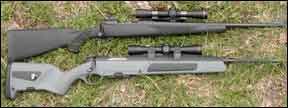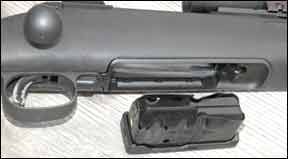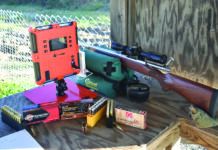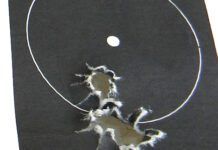The Savage Model 10 Scout is another attempt to emulate the Steyr Jeff Cooper Scout without breaking the bank. In our May 2011 issue, we tested the Steyr Scout against the new Ruger Gunsite Scout rifle, and though we thought the Ruger looked great, we also thought it was too heavy. We wondered why Ruger insisted on such a heavy, if durable, laminated stock for that gun. Savage put a synthetic, all-black stock on its version of the Scout, so we hoped it would “make weight,” as Cooper used to put it, which means be light enough to equal the original concept, which the Steyr barely does. We acquired a copy of the Savage Scout and put it to the test to see how it compared to the Steyr, with a few notes on the Ruger. This is what we found.

Savage 308 Model 10 FCM Scout
No. 18138 308 Winchester, $814
Our test rifle came with iron sights and a dull-black matte-blued metalwork that had a sort of acid-etched appearance that sometimes accompanies rust bluing. The stock was matte-black polymer with checkering and a very soft recoil pad. The rifle had the AccuTrigger, which we’ve come to know and love. There was a rear base for a ghost-ring aperture sight, which per the company website (www.SavageArms.com) was supposed to be included with the package. Unfortunately, the aperture sight fell off during our early testing and was lost. We did not get a sling with the test rifle. The front sight had a gold bead and provisions for a sight protector or hood, but one was not included. There was also a forward-extending rail to mount a proper Scout-type scope.
The barrel was free-floated all the way to the receiver with a generous gap at the edge of the barrel, which we thought was perhaps too generous. There was also a detachable magazine, nicely made and fitted flush with the bottom of the stock. There was a dished-out area in front of the magazine well, under the stock, into which you could stick your finger to work the serrated magazine release. The magazine box held only four rounds. Sadly, that (plus one) is the limit for this rifle. You cannot at this time use one of Savage’s 10-round in-line magazines as fitted to other rifles of its line, like the Model 10 BA or the Model 10 FCP-SR. We hope Savage can be persuaded to offer a 10-rounder in this Scout rifle, if for no other reason than the other two rifles, Steyr and Ruger, both have 10-round mags, and some shooters have to have them. Savage’s sales will be hurt, we suspect, without more capacity in the box. This rifle is, after all, in Savage’s Law-Enforcement line, so it would seem to be reasonable to ask for ten rounds in the box even if it adds a bit to the cost.
We found there is a trick to inserting the magazine into the rifle in a manner in which it will stay put. Insert the rear end first, and then swing the box firmly up into place, and listen for the final click. Otherwise, it will pop out after the first shot, or will fail to feed, both of which happened a couple of times.
The bolt knob is huge, which we liked. Getting the bolt out of the rifle was a bit new for us. Clear the gun, leave the bolt open, and press the trigger. Then press the removal button, located in front of the trigger guard, and withdraw the bolt. To get it back into the rifle, all that’s necessary is to press and hold the trigger fully back, and the bolt will then slide home. We liked this system after we got used to it. The bolt was quite slick, and promised to get slicker with use. Like the rest of the rifle, the bolt body and handle were dull matte-blued. The safety lever was conveniently

located and ambidextrous. It was behind the bolt, right in the valley of the bolt run. We found it easy to use. It had three positions. All the way back locked everything, bolt and trigger. Halfway forward, the shooter could work the bolt to cycle a round out of the chamber, and in that position the red dot was half uncovered. And all the way forward was the firing position, which displayed the red dot fully. The rear of the bolt also had a cocking indicator in the form of the white-metal firing pin, which was visible when cocked. The bolt had Sako-type extraction and plunger ejection that we found worked flawlessly.
We made sure all the stock and rail bolts were fully tightened, installed our Leupold Scout Scope, and took the rifle to the range. Our first groups were unimpressive no matter what ammo used, but then the Savage settled down. With our handload of a 308 target bullet, we made three-shot groups at 100 yards that averaged half an inch. That was nearly matched by the Federal Match ammo, but our Hirtenberger was a bit larger, on the order of 2.6 inches, as was the mil-spec mixed ball. Certainly anyone owning this rifle would be more than happy with that kind of accuracy, especially with the promise of rewarding a diligent search for the very best ammunition. This was better accuracy than either of the other two Scout rifles had shown. We noted a test target came with the rifle, fired with Federal Match ammo, and it was exactly what we got on average with that ammo, 0.7 inch.
What about weight? This rifle was about 3 ounces lighter than the Ruger in a similar configuration, which means it’s still on the too-heavy side, or so we thought, but a good step better than the Ruger. Unlike with the Ruger, there’s no apparent easy way to get the Savage’s weight down any more. The Steyr weighed nearly a pound less than the Savage, and it offered five sling-mount points, not just two as with the Ruger and Savage. The Savage’s barrel could be made a lot slimmer, and also could be cut two or even three inches shorter. That would help a lot. The bolt handle could be drilled, or made of lighter material. Not much could be done with the stock, but perhaps the action could be slimmed or skeletonized to some extent. However, let us not forget the Steyr offered less weight, an integral bipod, rail mount, two magazines, and a storage compartment. Yes, you pay for all that, but the cost is well justified.
Our Team Said: We absolutely loved the Savage’s trigger, which we believe sets a new standard for rifle triggers. The AccuTrigger beat the pants off the Ruger’s trigger, and was about as good as the adjustable one on the Steyr. The metal finish and overall workmanship were excellent, we thought, and the stock was fully functional, with workable checkering. The forward scope-mount rail worked well and was stout enough, we thought, and we liked the idea of Savage offering an aperture sight at no additional cost. We wish we had seen it, but would not have shot the rifle with it anyway. It mounted in a dedicated dovetail on the rear ring of the receiver. We think Savage needs to offer 10-round magazines, and then we’d say this rifle is a good deal better than the Ruger. As it is, if you can live with a four-round magazine, the Savage costs less than the Ruger, has way better accuracy, and has that wonderful trigger. No, its stock length is not readily adjustable, but in truth, you generally do that only once, and then let it alone. We gave the Savage a B grade, but with a 10-round magazine it would be an A.
0911-ACC-CHRONO-SAVAGE-MODEL-10.pdf
0911-SAVAGE-MODEL-10-REPORT-CARD.pdf


















